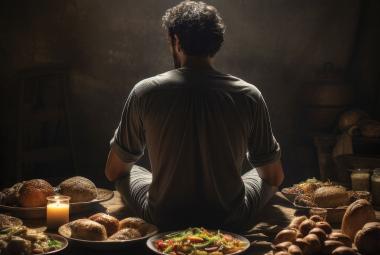Review
“One thing have I desired of the Lord, that will I seek after; that I may dwell in the house of the Lord all the days of my life, to behold the beauty of the Lord, and to inquire in His temple.” (Psalm 27:4)
For the past several months we have been exploring the spiritual connection between our worship times with the Lord and how the priests of Solomon’s Temple worshiped Him. There seems to be a valid Scriptural comparison between the true worshiper of God who “worships the Lord in spirit and truth” (John 4:23), and the priests who worshiped the Lord “in the beauty of holiness” at the Incense Altar. Even though the latter was under the Old Covenant, without Christ, the comparison is there and Scripture seems to suggest that it is important. (1 Corinthians 3:16; 2 Corinthians 6:16)
For those of you who are just joining us, the order of service for the priests was as follows: When the priests first entered the Inner Court, they immediately went to the Lavers of Bronze where they washed their hands and feet. Then they approached the Brazen Altar, where they sacrificed the animals in order to purge the sins of the people. Next, they immersed themselves bodily in the Molten Sea. And finally, they took a censer full of hot coals from the Brazen Altar, went into the temple where they changed their clothes and then proceeded to the Holy Place. In the Holy Place they took some incense, sprinkled it over the coals on the Golden Incense Altar, took off their shoes, prostrated themselves, and then worshiped the Lord in the “beauty of holiness.” (Exodus 25:22)
To me, this worship service is a model or a pattern of how the Lord wants us to deal with our sin, be reconciled to Him and allowed to enter His presence. The Lavers of Bronze, the Brazen Altar and the Molten Sea are representative of the three cleansing steps that God has given us in Scripture in order to wash ourselves from “all filthiness of [our] flesh and spirit” (2 Corinthians 7:1) and enabled to approach Him: 1) Confess and repent of our sin and self; 2) Give these things over to Him; and finally, 3) Read His Word and replace the lies with His truth.
Oneness with the Lord
Thus, our soul’s natural strength is dealt with on the Brazen Altar (in the Inner Court), but it’s not until we reach the Incense Altar (in the Holy Place) that we experience true oneness, communion and intercourse with Him. Our spirit has finally been strengthened so that it can now freely direct our soul in all things. This is the way God intended us to live from the very beginning. The Incense Altar symbolizes this complete union of our spirit with His Spirit.
God wants us to be “one,” not only positionally (which happens at our new birth), but also experientially (in our daily experience), even if it starts out only a few moments a day. Perhaps the following day we’ll be able to stay in this communion for an even longer period of time, and the day after that, even longer still. Only Jesus was able to stay in this perfect experiential communion with the Father continually, because He had no sin.
Experiential union with Christ - that deeper merging of our spirits - becomes the climax of our relationship with Him. This is the completion, the perfection and the “fulness of God” that Scripture talks about and that He has designed for every one of us. Everything on the inside and everything on the outside finally becomes His!
Again, the Incense Altar represents this experiential union of our spirits. But, just as the perfume from the Incense Altar retained its own unique properties as it rose from the altar (even though it was united with, mingled and joined with the cloud of fire), so we retain our own individuality and our own humanness when we become experientially united with God.
An analogy that might help give us more understanding of this paradox is that the Incense Altar actually was located in the Holy Place just outside the veil to the Holy of Holies. However, when reading Scripture, it sounds as if the Incense Altar was considered to be a part of the Holy of Holies. Listen to Leviticus 16:12-13, “And he shall take a censer full of burning coals of fire from off the altar before the Lord, and his hands full of sweet incense beaten small, and bring it within the veil: And he shall put the incense upon the fire before the Lord, that the cloud of the incense may cover the mercy seat that is upon the testimony...”
Likewise, we are considered to be positionally one with the Lord, because of our new birth, however, experientially it’s often a whole other story.
Offering of the Incense
Incense means “to blow or to breathe.” Throughout Scripture, incense is called “sweet smoke.” It represents our praise, our prayers and our worship. Incense and the Golden Altar were always associated with the Temple and its worship services. For example: Revelation 8:3-4 tells us, “And another angel came and stood at the altar, having a golden censer; and there was given unto him much incense, that he should offer it with the prayers of all saints upon the golden altar which was before the throne. And the smoke of the incense, which came with the prayers of the saints, ascended up before God...” (See also Psalm 141:2.)
Carrying that hot piece of coal from the Brazen Altar (as a symbol of our crucified life), placing it on the Incense Altar, and watching as the perfume and the fire become one, is a graphic picture of what it means to worship Him. As we offer God the incense of our wholly burnt lives, we become “one” just like that fire and wood did.
Incense represents the fragrance of our lives. A bad savor means an unholy or impure life; a good savor means a holy or pure life. When sin and self no longer form a barrier preventing our approach to God, then a sweet aroma can come up before Him. In other words, when we become “one” with Him we radiate the fragrance of His Life. That incense - that sweet fragrance of holiness - rises up to God as an acceptable offering. It’s the product of our sanctification and our purification. 2 Corinthians 2:15 tells us that “we are unto God a sweet savor of Christ.” That sweet fragrance “before the Lord” assures us access to His throne.
Malachi 1:11 tells us, however, that in the end times “[His] Name shall be great among the Gentiles, and in every place incense shall be offered unto [His] Name.” In other words, in these end times God wants all Christians everywhere and in every place to offer incense (worship) to His Name. It doesn’t matter who we are or where we are, the Lord wants us to seek Him, to offer incense and worship.
The Place God Meets with Us
The Golden Altar before the veil is said to be “the place that God meets with us.” Historically, there were three different places in the temple that God met with the priests: 1) at the Ark of the Covenant in the Holy of Holies (Exodus 25:22); 2) at the Incense Altar in the Holy Place (Exodus 30:6, 36); and, 3) at the Brazen Altar in the Inner Court (36); and, 3) at the Brazen Altar in the Inner Court (Exodus 29:42). Notice that each room of the temple is represented here. In like manner, even when we “feel” alone and abandoned in our difficult times, God promises to be with us no matter where we are. Now, we won’t hear Him as clearly if we are still in the Inner Court, but nevertheless He promises “never to leave us or forsake us,” even in the midst of the fire.
One of the reasons God created the sanctification process (the three steps of cleansing) in the first place was so that He might bring us near to Him. Numbers 16:9 validates this: “Seemeth it but a small thing unto you, that the God of Israel hath separated you [consecrated you] from the congregation of Israel, to bring you near to Himself....”
It’s interesting because if you recall, incense was the result of a sacrifice already given. In other words, it was never presented to the Lord without first being completely burnt. It was beaten small and then presented before Him on the altar where He promised to meet with them. (Leviticus 16:12) Likewise, He often teaches us humility (“being made small”) before we are able to “meet with Him.” Then, we’ll be able to bring before Him, in utter and complete adoration, the pure love (incense) that remains in our hearts.
Two-Way Communication
So, worship is really a two-way communication. It releases blessings in two directions. We come into His presence by loving and adoring Him, He, then, makes Himself known by communicating His Love back to us through revelation, insight and Love.
Here’s a personal example: About three years ago, I was experiencing an extremely difficult situation. I was embroiled in some circumstances that didn’t seem to have a solution. During one of my worship times, God gave me an incredible Scripture. It was one I had never seen before, and it fit my situation perfectly! “Though you have lien among the pots [in back rooms], yet shall you be as the wings of a dove covered with silver....” (Psalm 68:13)
This little verse expressed God’s personal voice to me and made me realize that He cared, even about this insignificant circumstance in my life. That knowledge not only carried me through some further stressful times, but it also gave me the hope that He knew exactly what was occurring in my life and that He would bring me through. Which, of course, He did!
A Scriptural example of this is Moses in Numbers 20:6-7. God not only spoke to Moses “face to face,” He also allowed him to see His glory. And as a result, Moses was changed. He received direction, hope and a solution to his problem. And the same is true for us. God reveals Himself when we worship Him not only to give us the strength to continue on, but also the revelation and the insight as to what to do. On another occasion when Moses saw God’s glory, Scripture tells us he immediately fell to his knees and worshiped. He, then, went on to pray, “O Lord, let my Lord, I pray Thee, go among us; ...and pardon our iniquity and our sin...” (Exodus 34:8-9)
In other words, that revelation of God’s glory not only changed Moses, but it also gave him God’s heart and compassion for others.
This, by the way, is the first recorded incident that mentions Moses “worshiping the Lord.” Before this, Scripture tells us that Moses prayed, he interceded, he wept and he pleaded with God, but it never speaks about him worshiping. In other words, something unique happened here. Moses saw God’s glory and it caused him to worship!
Seeing the manifestation of God’s glory births more worship in us. And, the more we worship and the more He reveals Himself to us, the deeper our intimacy will become. His presence will bring His Love, His direction and His peace. (Exodus 24:9-18)
“I pray Thee, if I have found grace in Thy sight, shew me now Thy way, that I may know Thee, that I may find grace in Thy sight...And He said, ‘My presence shall go with thee, and I will give thee rest.’” (Exodus 33:13-14)
To be continued next month: “Praying our Petitions and Praying the Scriptures.” This article has been excerpted, in part, from Nan’s book Private Worship: The Key to Joy.




